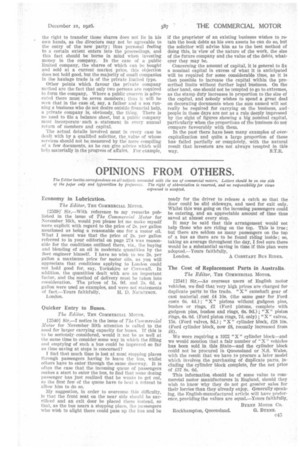OPINIONS FROM OTHERS.
Page 67

If you've noticed an error in this article please click here to report it so we can fix it.
The Editor invites corresPondence on all subjects connected with the use of commercial motors, Letters should be on One side of the paj,er only and tyPewritten by preference. The right of abbreviation is reserved, and no responsibility for views
expressed is accepted,
Economy in Lubrication.
The E elitor, THE COMMERCIAL MOTOR.
[25391 Sir,—With reference to my remarks published in the issue of The Commercial Motor for November 16th, would you please let me make myself more explicit with regard to the price of 2s, per gallon mentioned as being a reasonable one for a motor oil. What I meant was that the price of 28. per gallon referred to in your editorial on page 274 was reasonable for the conditions outlined there, viz., the buying and blending of an oil in moderate quantities by the fleet engineer himself,. I have no wish to see 2s. per gallon a maximum price for motor oils, as you will appreciate that conditions applying to London could not hold good for, say, Yorkshire or Cornwall. In addition, the quantities dealt with are an important factor, and the method of delivery must be taken, into consideration. The prices of 1s. 9d. and 28. 6d. a gallon were used as examples, and were not statements
of fact,—Yours faithfully, H. D. NICKTNSON. London.
Quicker Entry to Buses.
The Editor, TFIE COMMERCIAL MOTOR.
[2540:] Sir,—I notice in the issue of The Commercial Motor for November 30th attention is called to the need for larger carrying capacity for buses. If this is to be seriouslyconsidered, would it not he as well at the same time to consider some way in which the filling and emptying of such a bus could be improved so far as time saving at stops is concerned?
I find that much time is lost at most stopping places through passengers having to leave the bus, whilst others have to enter through the same doorway. It is often the case that the incoming queue of passengers makes a start to enter the bus, to find that some dozing passenger has just realized that he wants to get out, so the first few of the queue have to beat a retreat to allow him to do so.
My suggestion, in order to overcome this difficulty, is that the front seat on the near side should be sacrificed and an exit door be placed there instead, so that, as the bus nears a stopping place, the passengers Who wish to alight there could pass up the bus and be ready for the driver to release a catch so that the door could be slid sideways, and used for exit only. Whilst this was going on the incoming passengers could be entering, and an appreciable amount of time thus saved at almost every stop.
It may be said that this arrangement would not help those who are riding on the top. This is true; but there are seldom as many passengers on the top of a bus as there are to be found riding inside ; so, taking an average throughout the day, I feel sure there would be a substantial saving in time if this plan were adopted.--Yours faithfully,
London. A CONSTANT Bus RIDER.
The Cost of Replacement Parts in Australia The editor, Tx COMMERCIAL MOTOR.
[25411 Sir,—As overseas users of English motor vehicles, we find that very high prices are charged for duplicate parts to the trade. " X " camshaft gear of cast material cost 14 10s. (the same gear for Ford costs 6s. 4d.) ; " X " pistons without gudgeon pins, bushes or rings, 12 (Ford pistons, complete with gudgeon pins, bushes and rings, 6s. 9d.) ; "X" piston rings, 4s. 6d. (Ford piston rings, 7d. only) ; " X " valves, 15s. (Ford valves, 8d.) ; " X " cylinder block, /28 10s. (Ford cylinder block, now 18, recently increased from 16).
We were requiring a 1922 "X" cylinder block—and we would mention that a fair number of "X" vehicles has been sold in this State—and the cylinder block could not he procured in Queensland or N.S. Wales, with the result that we have to procure a later model which involves the purchasing of duplicate parts, including the cylinder block complete, for the net price of 157 Ss. 6d.
This information should be of some value to commercial motor manufacturers in England, should they wish to know why they do not get greater sales for their lorries than they already enjoy. Generally speaking, the English-manufactured article will have preference, providing the values are equal.—Yours faithfully,
BYRNE MOTOR CO.
Rockhampton, Queensland. G. BYRNE.












































































































